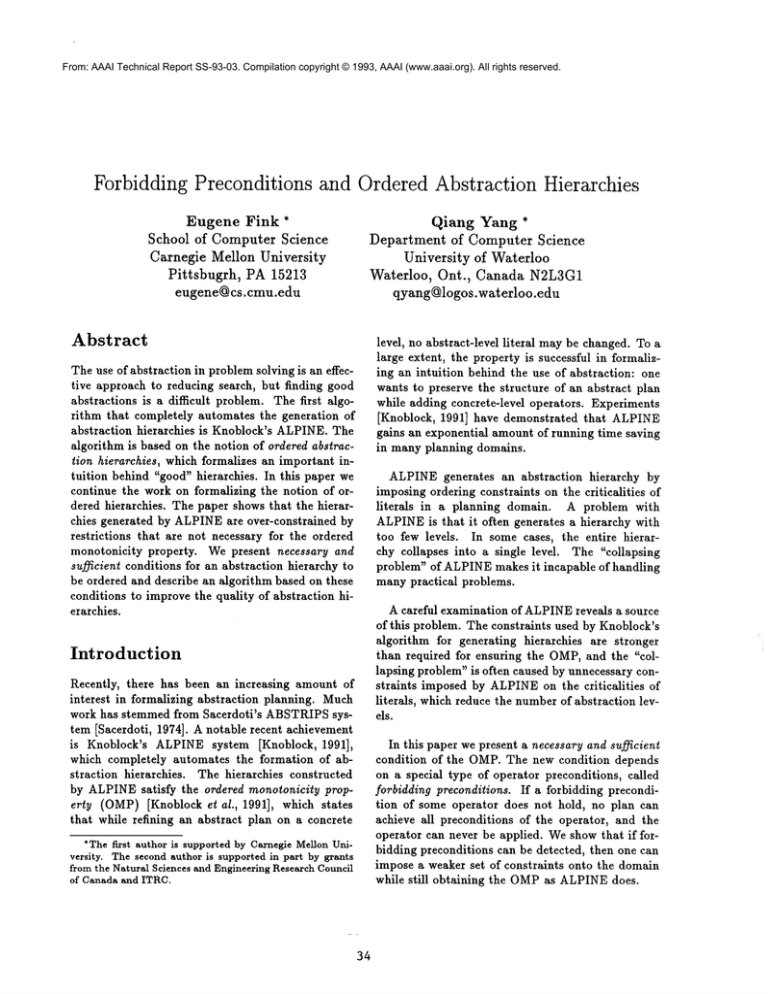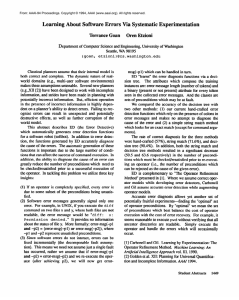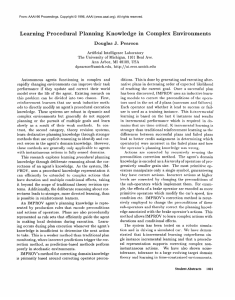
From: AAAI Technical Report SS-93-03. Compilation copyright © 1993, AAAI (www.aaai.org). All rights reserved.
Forbidding Preconditions and OrderedAbstraction Hierarchies
Eugene Pink *
School of Computer Science
Carnegie Mellon University
Pittsbugrh,
PA 15213
eugene@cs.cmu.edu
Qiang Yang *
Department
of Computer Science
University
of Waterloo
Waterloo,
Ont.,
Canada N2L3G1
qyang@logos.waterloo.edu
Abstract
The use of abstraction in problem solving is an effective approach to reducing search, but finding good
abstractions is a difficult problem. The first algorithm that completely automates the generation of
abstraction hierarchies is Knoblock’s ALPINE.The
algorithm is based on the notion of ordered abstraction hierarchies, which formalizes an important intuition behind "good" hierarchies. In this paper we
continue the work on formalizing the notion of ordered hierarchies. The paper shows that the hierarchies generated by ALPINEare over-constrained by
restrictions that are not necessary for the ordered
monotonicity property. Wepresent necessary and
sufficient conditions for an abstraction hierarchy to
be ordered and describe an algorithm based on these
conditions to improve the quality of abstraction hierarchies.
Introduction
Recently, there has been an increasing amount of
interest in formalizing abstraction planning. Much
work has stemmed from Sacerdoti’s ABSTRIPSsystem [Sacerdoti, 1974]. A notable recent achievement
is Knoblock’s ALPINEsystem [Knoblock, 1991],
which completely automates the formation of abstraction hierarchies. The hierarchies constructed
by ALPINEsatisfy the ordered monotonicity property (OMP)[Knoblock et al., 1991], which states
that while refining an abstract plan on a concrete
*The first
author is supported
by Carnegie
Mellon University.
The second author is supported
in part by grants
from the Natural Sciences
and Engineering
Research Council
of Canada and ITRC.
34
level, no abstract-level literal may be changed. To a
large extent, the property is successful in formalizing an intuition behind the use of abstraction: one
wants to preserve the structure of an abstract plan
while adding concrete-level operators. Experiments
[Knoblock, 1991] have demonstrated that ALPINE
gains an exponential amount of running time saving
in many planning domains.
ALPINEgenerates an abstraction
hierarchy by
imposing ordering constraints on the criticalities
of
literals
in a planning domain. A problem with
ALPINEis that it often generates a hierarchy with
too few levels. In some cases, the entire hierarchy collapses into a single level. The "collapsing
problem" of ALPINEmakes it incapable of handling
many practical problems.
A careful examination of ALPINEreveals a source
of this problem. The constraints used by Knoblock’s
algorithm for generating hierarchies are stronger
than required for ensuring the OMP,and the "collapsing problem" is often caused by unnecessary constraints imposed by ALPINEon the criticalities
of
literals, which reduce the numberof abstraction levels.
In this paper we present a necessary and sufficient
condition of the OMP.The new condition depends
on a special type of operator preconditions, called
forbidding preconditions. If a forbidding precondition of some operator does not hold, no plan can
achieve all preconditions of the operator, and the
operator can never be applied. Weshow that if forbidding preconditions can be detected, then one can
impose a weaker set of constraints onto the domain
while still obtaining the OMPas ALPINEdoes.
Ordered hierarchies
Wefollow the terminology used in [Knoblock et al.,
1991]. A planning domainconsists of a set ofliterals
and a set of operators. Eachoperator 12 is defined by
a set of precondi~ionliberals Pre(12) and effect literals
Eft(12). A state of the worldis a set ofliterals. A plan
II -- (121, .., ova) is a sequenceof operators, whichcan
be applied to a state by executing each operator in
order. A plan II : (121, .., 12n) is correct relative to
an initial state if the preconditions of each operator
are satisfied in the state in which the operator is
applied, i.e. (Vi E [1..n]) Pre(12i) C_ Si-1.
A planning problem is a pair (So, Sg), where So
an initial state, and Sg is a goal state. A plan II is
correct relative to the planning problem (So, Sg)
II is correct relative to So and the goal is satisfied in
the final state: Sg C Sn.
To build an abstraction hierarchy, one can associate some natural number, called criticality,
with
every literal in the planning domain. While solving a
problemat the i-th level of abstraction, we ignore all
literals with the criticalities less than i. Abstraction
planning is usually done in a top-down manner: first
we find a solution at the highest level of abstraction.
Then we refine it to account for successive levels of
details.
For a given set of operators, different criticality assignments may result in different behavior in
problem solving. Ordered hierarchies, introduced
in [Knoblocket al., 1991], satisfy the condition that
every refinement of an abstract plan leaves the abstract plan structurally unchanged. More precisely,
thus a plan for changing the position of the robot
cannot change anything on the upper level.
To guarantee the OMP, ALPINEimposes ordering constraints on literals in the domain based on
the following syntactic restrictions:
Restrictions
1 and 2
Let O be the set of the operators in a domain.
V12E O, V/i, 12 E Eft(12), and Vl E Pre(12) such that
l can be achieved by some operator,
(1) crit(ll) = crit(12), and
(2) crit(ll) >_crit(l).
(2) An abstraction hierarchy is ordered if every justified refinement of every correct plan is an ordered
refinement.
Thus, all effects of an operator have the same criticality, and their criticality is at least as great as the
criticalities
of operator’s preconditions (except the
preconditions that cannot be achieved by any operator).
Restriction 1 ensures that while adding an operator to achieve a literal ll on somelevel of abstraction,
we change only literals on the same level, since the
operator does not have effects on other levels. The
intuition behind the second restriction is a little bit
more complicated. After inserting some operator 12
to achieve li, we may need to achieve the preconditions of 12. Restriction 2 ensures that the criticalities
of its preconditions is no larger than the criticality
of li, and thus we do not change anything on higher
levels while achieving them.
It turns out that the second restriction is stronger
than needed to guarantee the OMP.Thus, Restrictions 1 and 2 are only sufficient, but not necessary.
To demonstrate this~ we consider a simple robot
world in which a robot can unlock and open a safe
using two keys. The robot can unlock the safe if he
has both keys, and the unlocked safe may be opened.
If the safe is open, the robot can put the keys into
the safe. The robot is limited in his ability to pick
up a key dropped onto the floor: when he picks up
a key, he loses the other one. This domain may be
described with 5 literals:
have key 1
unlocked
keys in safe
have key 2
open
For example, consider a planning domain with a
robot that may travel within several rooms and turn
on and off switches. Wemay build a two-level ordered hierarchy for this domain, where the status of
switches is on the upper level and the position of
the robot is on the lower level. Travelling between
rooms does not change the status of switches, and
and the negations of these literals. The formal description of the operators is shownin Figure 1.
It can be shown that ALPINEfails to generate a
hierarchy for this domain: all literals collapse into
a single level of abstraction. The constraints are
shown in Figure 2, where arrows denote "<" relations between the criticalities
of literals. The only
Definition
1 (Ordered hierarchy)
(1) A refinement of the (i + 1)-st level plan II is
called ordered if none of the operators inserted into
II changesthe value of any literal with the criticality
value higher than i.
35
PiekKeyl
]
Pick
Key2
[
Preconds
Effects
Preconds
Effects
keys not in safe
have key 1
do not have key 2
keys not in safe
have key 2
do not have key 1
[ Unloct
Preconds
Open Safe
Effects
have key 1 unlocked
have key 2
]
Put
Keys
[
Preconds Effects
Preconds ] Effects
unlocked
open
have key 2 keys in safe
have key 1
open
Figure 1: Operators
have key 1 ]
j open
keys in safe ~khave key 1
~ unlocked
3
have key 2
2
keys in safe
1
open
0F
have key 2
Figure 2: Constraints
unlocked
Figure 3: Ordered hierarchy
wayto satisfy the constraints is to makethe criticalities of all literals equal to each other, andthus the
1.
hierarchycollapses into a single level
Observe howeverthat once the robot has dropped
one of the keys, he can never hold both of them
again, and therefore he can never open the safe.
In other words, if one of the two preconditions of
the operator Unlock Safe, either "have key 1" or
"have key 2", does not hold, the planner maynever
achieve both of them. So an intelligent planning
systemshould treat these preconditionsas unachievable. Since Restriction 2 musthold only for achievable preconditions, we mayremoveconstraints imposed on the preconditions of the operator Unlock
Safe. These constraints are crossed with a vertical
line in Figure 2. Similarly, wedo not needto impose
constraints on the preconditions "have key 1" and
"have key 2" of the operator Put Keys. One may
1 Onemayverify that the hierarchycollapsesinto a single level evenif weuse problem-speclfic
orderedrestrictions
[Knoblock
et al., 1991].
36
verify that without these two constraints we obtain
the four-level ordered hierarchy shownin Figure 3.
Necessary and sufficient
tions
condi-
To formalize the observation madein the example,
weintroduce the notion of forbidding preconditions.
Informally, a precondition l of an operator a is forbidding if, onceI does not hold, wecan never achieve
the preconditions of a, and thus wecan never apply
a. In the above example, the literals "have key 1"
and "have key 2" are forbidding preconditions of the
operator UnlockSafe.
Definition 2 A preconditionI of an operator c~ is a
forbidding precondition if for any state So in which
l does not hold, no correct plan with the initial state
So may contain a.
Note that the concept of forbidding preconditions
is different from that of filter preconditions used in
NONLIN
[Tate, 1977]. Filter preconditions are used
to distinguish the different context-dependent effects
of operators. The major difference between the two
is that a filter precondition can be made true and
false several times in a plan, while the preconditions
of an operator containing a forbidding precondition
will never becometrue after the forbidding precondition is made false. The usefulness of forbidding
preconditions is not affected by how a planner is
implemented, while filter preconditions have been
shownto be ineffective for backwards-chalning planners [Collins and Pryor, 1992].
Nowwe state the modified restrictions on the criticality values of literals, suggested in our example.
Restrictions
1 and 2’
Let O be the set of the operators in a domain.
Vc~l E O, Vll, 12 E Eft(a1), and Vl ¯ Pre(c~l),
1. crit(l,)=crit(l),
T. if I is not a forbidding precondition of a,
then crit(ll) >_erit(1).
Our first restriction is the same as Restriction 1 of
the ALPINEsystem. Let us consider the difference between Restriction 2, used by ALPINE,and
our Restriction T. ALPINE’srestriction
imposes
constraints onto all achievable preconditions of an
operator, i.e. onto the preconditions that may be
achieved by applying some other operators. Our restriction constrains the critiealities of non-forbidding
preconditions. Observe that ifa precondition cannot
be achieved by any operator, it is certainly forbidding. Thus, Restriction 2’ constrains the criticalities of fewer preconditions than the corresponding
restriction of ALPINE.Since our restrictions impose
less constraints, they maybe used to generate finergrained abstraction hierarchies. Restrictions 1 and
2’ are also necessary conditions of the OMPof a
hierarchy, and thus they cannot be further relaxed.
Theorem 1 An abstraction hierarchy is ordered if
and only if it satisfies Restrictions 1 and 2’.
A proof of the theorem may be found in [Fink, 1992].
Observe that Restrictions 1 and 2’ impose the
same type of ordering constraints as ALPINE’srestrictions,
and thus they may be used by ALPINE
to generate hierarchies. However, we first have to
determine which preconditions are forbidding.
37
1. paint all preconditions of a black
2. for every black precondition 1 of c~ do
for every operator o~l do
if c~l achieves l and does not negate
any black precondition of a
then paint l white
3. if some precondition is painted white by Step 2
then go back to Step 2
Table 1: Finding forbidding preconditions of c~
Finding forbidding
preconditions
Consider again our robot example. Once the robot
dropped one of the keys, he can never hold both of
them again: if the robot picks key 1, he drops key
2, and if he picks key 2, he loses key 1. This example suggests the following intuition of forbidding
preconditions of an operator: preconditions ll, .., lk
are forbidding if every operator al that achieves one
of them negates some other of these preconditions.
An operator ~1 negates a literal l~ if li never holds
after the execution of c~1. This happens if either
(1) the negation of/i, -~ll, is an effect ofal,
(2) ~li is a precondition of c~l, and c~l does
not achieve I~.
Wecan use this observation to find (some of the)
forbidding preconditions of operators.
The algorithm for finding forbidding preconditions
of c~ is shown in Table 1. Weuse two colors, black
and white, to paint the preconditions of ~. Initially
all preconditions are black. If we discover that some
black precondition may be achieved without negating any other black precondition, we paint it white.
Uponthe execution of the algorithm, the preconditions of ~ are painted such a way that any operator achieving some black precondition of c~ always
negates some other black precondition. Thus, once
some black precondition does not hold, we cannot
achieve all black preconditions of a, and we may
never apply a. Therefore, all black preconditions
are forbidding.
For example, if we apply this algorithm to the
operator Put Keys, the precondition "open" will be
painted white, since it may be achieved by the operator Open Safe without negating any other preconditions. On the other hand, the preconditions
"have key 1" and "have key 2" will remain black,
because every operator that achieves one of them
always negates the other. The algorithm conclude
that these two preconditions are forbidding.
The described algorithm is based on a sufficient
condition for finding forbidding preconditions: all
preconditions that remain black are certainly forbidding, but some white preconditions may be forbidding as well. Wemay use another method to find
some non-forbidding preconditions of a. For each
white precondition l of c~, we use a planning algorithm to find a plan that achieves all preconditions
of a from any initial state in which I does not hold.
If we find a state S in which I does not hold and a
plan H that achieves the preconditions of ~ starting
from S, then I is not a forbidding precondition of ¢x.
If we limit the search depth of planning algorithm by
some constant, then the running time of this method
is polynomial.
For example, suppose we apply such an Mgorithm
to the precondition "open" of the operator Put Keys.
The algorithm will find that the preconditions of Put
Keys may be achieved from the state S ={not open,
unlocked, have key 1, have key 2}, by executing a
one-operator plan H =(OpenSafe). Since the literal
"open" does not hold in S, the algorithm concludes
that it is not a forbidding precondition of Put Keys.
After we apply the two algorithms described
above, there may still be some preconditions about
which we do not know whether they are forbidding.
In [Fink, 1992] we present an inductive learning algorithm that finds forbidding preconditions among
them while solving planning problems. Initially the
algorithm imposes constraints only on the preconditions that are definitely not forbidding. If some
of the remaining preconditions are not forbidding
either, it may fail to impose some necessary constraints, which would lead to problems during abstraction planning. However, when such problems
occur, they reveal the lack of constraints, and the
necessary additional constraints are imposed.
Conclusion
This paper describes an extension of the ALPINE
algorithm for automatically generating abstraction
hierarchies. Using the notion of forbidding preconditions, we are able to generate ordered hierarchies
where ALPINEfails. The paper extends the theory
of abstraction planning by presenting necessary and
sufficient conditions of the OMPfor abstraction hi-
38
erarchies. The notion of forbidding preconditions is
also useful for non-hierarchical planning, since the
knowledge of such preconditions Mlowsus to reduce
the branching factor of search by detecting unachievable subgoals during planning process.
References
[Bacchus and Yang, 1991] Fahiem Bacchus and Qiang Yang. The downward refinement property.
In Proceedings of the International Joint Conference on Artificial Intelligence, p 286-292, 1991.
[Collins and Pryor, 1992] Gregg Collins and Louise
Pryor. Achieving the functionality of filter conditions in a partial order planner. In Proceedings
of the Tenth National Conference of Artificial Intelligence, pages 375-380, 1992
[Fink, 1992] Eugene Fink. Justified plans and ordered hierarchies. Master’s thesis, University
of Waterloo, Department of Computer Science,
Waterloo, Canada, 1992. Tech. Report CS-92-42.
[Knoblock, 1991] Craig A. Knoblock. Automatically Generating Abstractions for Problem Solving. PhD thesis, School of Computer Science,
Carnegie Mellon University, 1991. Tech. Report
CMU-CS-91-120.
[Knoblock et al., 1991] Craig Knoblock, Josh Tenenberg, and Qiang Yang. Characterizing abstraction hierarchies for planning. In Proceedings of
the Ninth National Conference of Artificial Intelligence, pages 692-697, 1991.
[Sacerdoti, 1974] Earl Sacerdoti. Planning in a hierarchy of abstraction spaces. Artificial Intelligence, 5, pages 115-135, 1974.
[Siklossy and Dreussi, 1973] L.Siklossy and J. Dreussi. An Efficient Robot Planner which generates its own procedures. In Proceedings of the
Third International Join* Conference on Artificial Intelligence, pages 423-430. Morgan Kaufmann, 1973.
[Tate, 1977] Austin Tare. Generating Project Networks. In Proceedings of the Fifth International Joint Conferenceon Artificial Intelligence,
pages 888-893, 1977.






![Successful Universities - Home [ehelf.nu.edu.kz]](http://s2.studylib.net/store/data/005473189_1-c385f0ba098128b08458e724de79d96a-300x300.png)